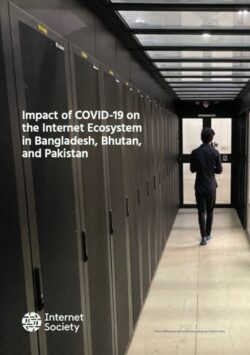Key Findings
- Internet performance was negatively affected in Bangladesh, Bhutan, and Pakistan during the lockdown period of the COVID-19 pandemic (first two quarters of 2020).
- During the lockdown period, data traffic increased in Bangladesh (up 21 percent), Bhutan (up 25 to 30 percent), and Pakistan (up 19 percent).
- Average broadband speed in these countries is well below par as compared with other countries in the Asia-Pacific and even below the average of South and Southwest Asia. The exception is Pakistan’s mobile broadband.
- The Internet Society conducted a user survey of Internet performance during the COVID-19 pandemic (first two quarters of 2020) in Bangladesh, Bhutan, and Pakistan. The results show that:
- 62 percent of the total respondents faced regular Internet performance issues during the pandemic.
- Social media platforms, over-the-top services (e.g., online video streaming) and e-learning were the top user activities on the Internet during COVID-19 lockdown.
- 68 percent of the total respondents faced problems with e-learning, and 60 percent found it difficult to work from home, both being the top two adverse implications reported by users in all these countries.
- Slow browsing (56 percent), low download speed (51 percent), and frequent disconnection (48 percent) are the most common underlying problems with Internet access.
- Users became more dissatisfied with the speed, reliability, and steadiness of their Internet connections, and also with customer service.
- Users are spending more money on their Internet connection during the pandemic.
- Most of the users (except Bhutan) either did not believe or were not aware that their government or ISP made any special efforts to improve the Internet connectivity during the COVID-19 pandemic.
- The government approach towards handling the unexpected traffic surge requires a strategic shift from “immediate but short term” to “proactive and long term.”
- Renewed government efforts are required in Bangladesh and Bhutan to overcome the international connectivity challenges, by increasing submarine fiber optic links.
- Fixed line penetration is critically low in these countries, which puts huge pressure on the mobile networks carrying bulk of the subscriber share.
- Low spectrum allocation and even lower fiber-to-tower ratio result in quality-of-service issues on the mobile networks.
- Digital content infrastructure is underdeveloped with lack of local content and applications.
- There exists a strong technical and business case to deploy more Internet Exchange Points (IXPs) that are vital elements of the Internet infrastructure.
Introduction
Almost a year and a half into the COVID-19 pandemic, the Internet has taken center stage to sustain life and business amid the various “waves and variants” of the novel coronavirus. States have adopted swift measures, using digital technologies, to empower their citizens during lockdowns and vaccination drives. It is estimated that the crisis has accelerated the adoption of a wide range of digital technologies by at least two years[1].
While every country is striving for digital transformation, the unprecedented uptake of remote education, work-from-home, e-commerce, e-government services, and content consumption on social media and streaming platforms put serious question marks on the resilience and capacity of the global Internet infrastructure. Despite initial setbacks, Internet infrastructure withstood the traffic spikes and bandwidth demands, thanks to measures adopted by governments and industry actors.
Quality-of-service issues became evident and deficiencies in the Internet value chain got exposed in many parts of the world, especially in developing countries, across different parameters such as speed and reliability. The pre-existing shortfalls in the digital outlook in terms of inclusion, speed, coverage, and affordability were accentuated, putting further pressure on states to take reactive measures on prevailing problems. Now, Internet traffic patterns are coming back to pre-COVID-19 levels (before March 2020), but the question remains: What can be done on the national level to sustain (or improve) the service quality during disaster situations, when Internet access is needed the most by citizens?
Endnotes
[1] Rana Foroohar, “Big Tech’s viral boom could be its undoing,” Financial Times, May 17, 2020; Richard Waters, “Lockdown has brought the digital future forward — but will we slip back?” Financial Times, May 1, 2020.
